CX554101 INTRODUCTION TO MARKETING Student Name: Student ID:
VerifiedAdded on 2023/01/18
|14
|4007
|22
AI Summary
Contribute Materials
Your contribution can guide someone’s learning journey. Share your
documents today.

CX554101
INTRODUCTION TO MARKETING
Student Name:
Student ID:
University Name:
Student Name and ID Page 1
INTRODUCTION TO MARKETING
Student Name:
Student ID:
University Name:
Student Name and ID Page 1
Secure Best Marks with AI Grader
Need help grading? Try our AI Grader for instant feedback on your assignments.
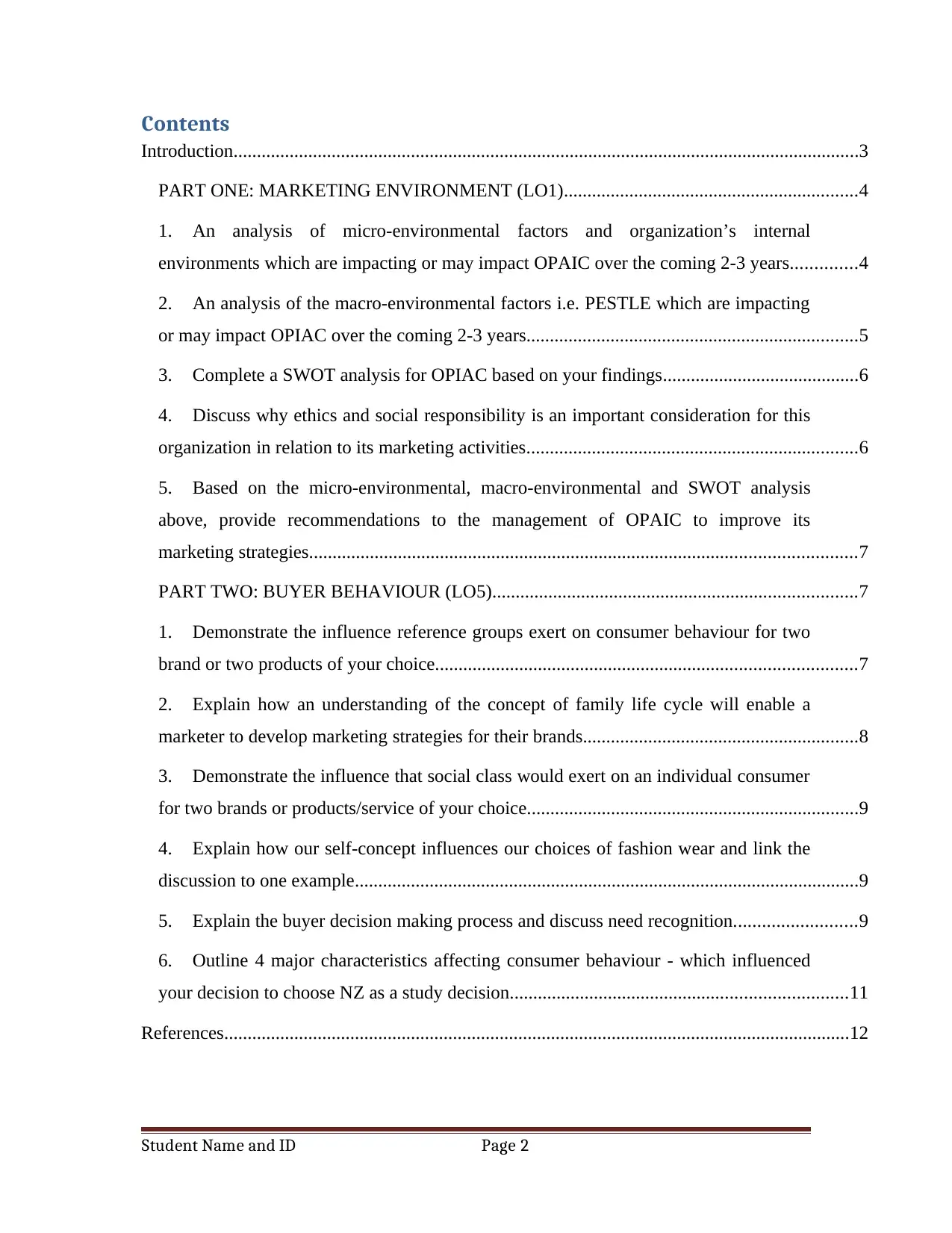
Contents
Introduction......................................................................................................................................3
PART ONE: MARKETING ENVIRONMENT (LO1)...............................................................4
1. An analysis of micro-environmental factors and organization’s internal
environments which are impacting or may impact OPAIC over the coming 2-3 years..............4
2. An analysis of the macro-environmental factors i.e. PESTLE which are impacting
or may impact OPIAC over the coming 2-3 years.......................................................................5
3. Complete a SWOT analysis for OPIAC based on your findings..........................................6
4. Discuss why ethics and social responsibility is an important consideration for this
organization in relation to its marketing activities.......................................................................6
5. Based on the micro-environmental, macro-environmental and SWOT analysis
above, provide recommendations to the management of OPAIC to improve its
marketing strategies.....................................................................................................................7
PART TWO: BUYER BEHAVIOUR (LO5)..............................................................................7
1. Demonstrate the influence reference groups exert on consumer behaviour for two
brand or two products of your choice..........................................................................................7
2. Explain how an understanding of the concept of family life cycle will enable a
marketer to develop marketing strategies for their brands...........................................................8
3. Demonstrate the influence that social class would exert on an individual consumer
for two brands or products/service of your choice.......................................................................9
4. Explain how our self-concept influences our choices of fashion wear and link the
discussion to one example............................................................................................................9
5. Explain the buyer decision making process and discuss need recognition..........................9
6. Outline 4 major characteristics affecting consumer behaviour - which influenced
your decision to choose NZ as a study decision........................................................................11
References......................................................................................................................................12
Student Name and ID Page 2
Introduction......................................................................................................................................3
PART ONE: MARKETING ENVIRONMENT (LO1)...............................................................4
1. An analysis of micro-environmental factors and organization’s internal
environments which are impacting or may impact OPAIC over the coming 2-3 years..............4
2. An analysis of the macro-environmental factors i.e. PESTLE which are impacting
or may impact OPIAC over the coming 2-3 years.......................................................................5
3. Complete a SWOT analysis for OPIAC based on your findings..........................................6
4. Discuss why ethics and social responsibility is an important consideration for this
organization in relation to its marketing activities.......................................................................6
5. Based on the micro-environmental, macro-environmental and SWOT analysis
above, provide recommendations to the management of OPAIC to improve its
marketing strategies.....................................................................................................................7
PART TWO: BUYER BEHAVIOUR (LO5)..............................................................................7
1. Demonstrate the influence reference groups exert on consumer behaviour for two
brand or two products of your choice..........................................................................................7
2. Explain how an understanding of the concept of family life cycle will enable a
marketer to develop marketing strategies for their brands...........................................................8
3. Demonstrate the influence that social class would exert on an individual consumer
for two brands or products/service of your choice.......................................................................9
4. Explain how our self-concept influences our choices of fashion wear and link the
discussion to one example............................................................................................................9
5. Explain the buyer decision making process and discuss need recognition..........................9
6. Outline 4 major characteristics affecting consumer behaviour - which influenced
your decision to choose NZ as a study decision........................................................................11
References......................................................................................................................................12
Student Name and ID Page 2

Introduction
According to Griffin, et al., (2013) the term ‘marketing’ can be described to build
relationships with customers eventually leading towards continuous customer
satisfaction. Achieving customer satisfaction cannot be done overnight. An effective
marketing strategy is needed for cautiously outlining the blueprint in order to find
customers.
(Source: bookdepository.com)
According to Tsygankova & Ponomarenko (2016), marketing can also comprehend as a
science involved in the selection of target markets by the means of market analysis and
segmentation, having a complete insight on buying behaviour for providing the best
value to customers. Although marketing is widely perceived as a sign of success for a
business, it actually is just a matter of point of view. According to Repovienė (2017),
marketing is just not all about personal selling or advertising. It comprises of activities
like public relations, sales promotion, advertising, social media, pricing, distribution and
many other functions. The key purpose of this study is to understand the marketing
environment and its impact on marketing decisions besides comprehending the factors
that influence buyer behaviour.
Student Name and ID Page 3
According to Griffin, et al., (2013) the term ‘marketing’ can be described to build
relationships with customers eventually leading towards continuous customer
satisfaction. Achieving customer satisfaction cannot be done overnight. An effective
marketing strategy is needed for cautiously outlining the blueprint in order to find
customers.
(Source: bookdepository.com)
According to Tsygankova & Ponomarenko (2016), marketing can also comprehend as a
science involved in the selection of target markets by the means of market analysis and
segmentation, having a complete insight on buying behaviour for providing the best
value to customers. Although marketing is widely perceived as a sign of success for a
business, it actually is just a matter of point of view. According to Repovienė (2017),
marketing is just not all about personal selling or advertising. It comprises of activities
like public relations, sales promotion, advertising, social media, pricing, distribution and
many other functions. The key purpose of this study is to understand the marketing
environment and its impact on marketing decisions besides comprehending the factors
that influence buyer behaviour.
Student Name and ID Page 3
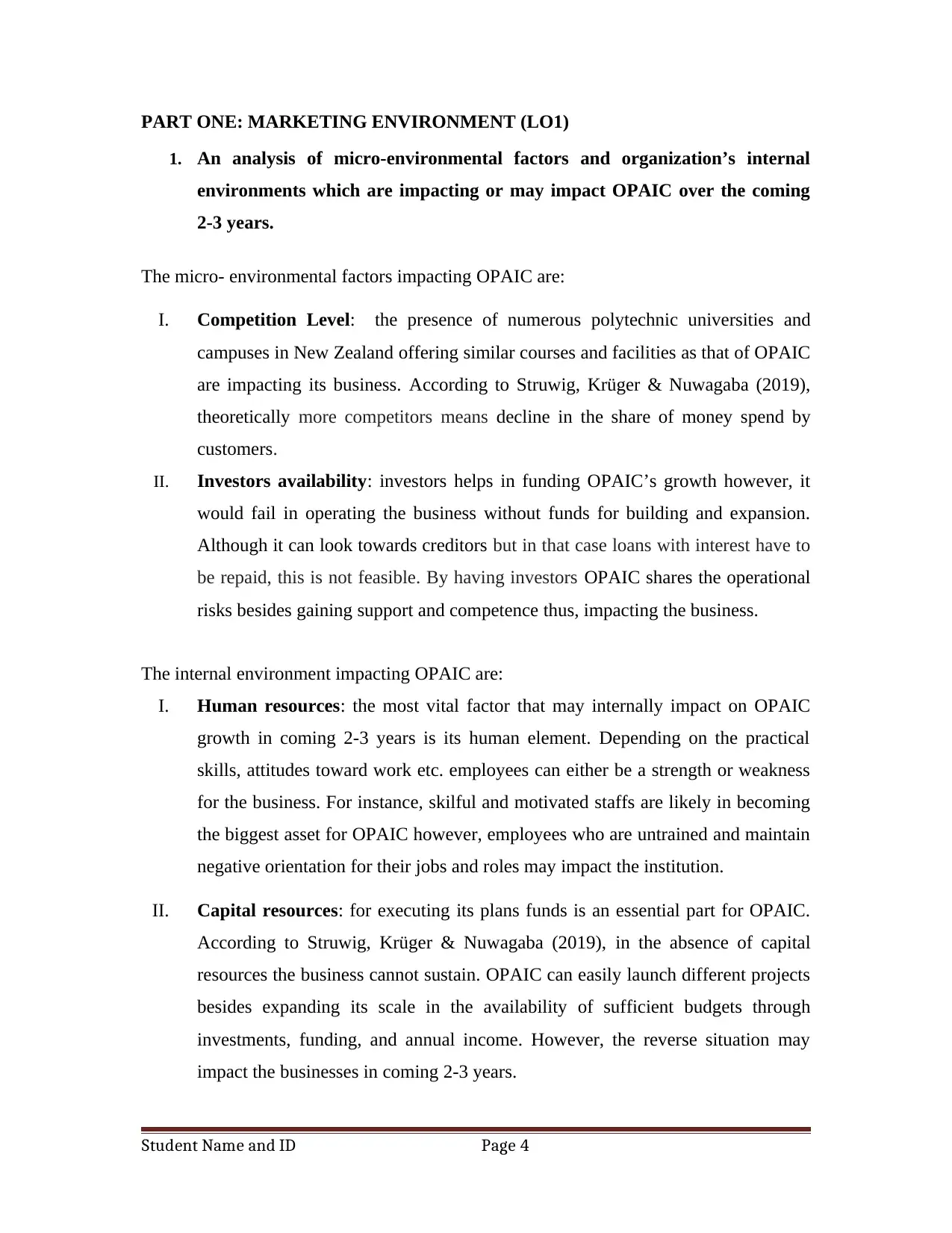
PART ONE: MARKETING ENVIRONMENT (LO1)
1. An analysis of micro-environmental factors and organization’s internal
environments which are impacting or may impact OPAIC over the coming
2-3 years.
The micro- environmental factors impacting OPAIC are:
I. Competition Level: the presence of numerous polytechnic universities and
campuses in New Zealand offering similar courses and facilities as that of OPAIC
are impacting its business. According to Struwig, Krüger & Nuwagaba (2019),
theoretically more competitors means decline in the share of money spend by
customers.
II. Investors availability: investors helps in funding OPAIC’s growth however, it
would fail in operating the business without funds for building and expansion.
Although it can look towards creditors but in that case loans with interest have to
be repaid, this is not feasible. By having investors OPAIC shares the operational
risks besides gaining support and competence thus, impacting the business.
The internal environment impacting OPAIC are:
I. Human resources: the most vital factor that may internally impact on OPAIC
growth in coming 2-3 years is its human element. Depending on the practical
skills, attitudes toward work etc. employees can either be a strength or weakness
for the business. For instance, skilful and motivated staffs are likely in becoming
the biggest asset for OPAIC however, employees who are untrained and maintain
negative orientation for their jobs and roles may impact the institution.
II. Capital resources: for executing its plans funds is an essential part for OPAIC.
According to Struwig, Krüger & Nuwagaba (2019), in the absence of capital
resources the business cannot sustain. OPAIC can easily launch different projects
besides expanding its scale in the availability of sufficient budgets through
investments, funding, and annual income. However, the reverse situation may
impact the businesses in coming 2-3 years.
Student Name and ID Page 4
1. An analysis of micro-environmental factors and organization’s internal
environments which are impacting or may impact OPAIC over the coming
2-3 years.
The micro- environmental factors impacting OPAIC are:
I. Competition Level: the presence of numerous polytechnic universities and
campuses in New Zealand offering similar courses and facilities as that of OPAIC
are impacting its business. According to Struwig, Krüger & Nuwagaba (2019),
theoretically more competitors means decline in the share of money spend by
customers.
II. Investors availability: investors helps in funding OPAIC’s growth however, it
would fail in operating the business without funds for building and expansion.
Although it can look towards creditors but in that case loans with interest have to
be repaid, this is not feasible. By having investors OPAIC shares the operational
risks besides gaining support and competence thus, impacting the business.
The internal environment impacting OPAIC are:
I. Human resources: the most vital factor that may internally impact on OPAIC
growth in coming 2-3 years is its human element. Depending on the practical
skills, attitudes toward work etc. employees can either be a strength or weakness
for the business. For instance, skilful and motivated staffs are likely in becoming
the biggest asset for OPAIC however, employees who are untrained and maintain
negative orientation for their jobs and roles may impact the institution.
II. Capital resources: for executing its plans funds is an essential part for OPAIC.
According to Struwig, Krüger & Nuwagaba (2019), in the absence of capital
resources the business cannot sustain. OPAIC can easily launch different projects
besides expanding its scale in the availability of sufficient budgets through
investments, funding, and annual income. However, the reverse situation may
impact the businesses in coming 2-3 years.
Student Name and ID Page 4
Secure Best Marks with AI Grader
Need help grading? Try our AI Grader for instant feedback on your assignments.

2. An analysis of the macro-environmental factors i.e. PESTLE which are
impacting or may impact OPIAC over the coming 2-3 years.
PESTEL Analysis
I. Political Factors: while decision makings many political factors exist such as
privatization of many organizations in New Zealand’s education industry
affecting profitability; government actions that might raise risks of industry
failures etc. may impact OPAIC in the coming 2-3 years. For instance, any kind
of curriculum changes within short lead times may impact institution.
II. Economic Factors: the overall costs involved in education are a considerable
economic factor that might impact OPAIC in the coming 2-3 years. According to
Trifu, Girneata & Potcovaru (2014) costs of resources (books or papers,
technology solutions, teaching and non-teaching staffs), shortage of material in
domestic and overseas markets, ability of parents in raising funds for
extracurricular activities, local or central government decisions for funding,
closure of local industry affecting the plans to raise funds etc. are certain
economic factors.
III. Social Factors: usually these are the factors affecting people’s lifestyle such as
family, religion, or health; changing over time. The social factor that may impact
OPAIC in the coming 2-3 years are demographic changes influencing enrolment;
changes in local population, which will either decrease or increase students
number; changes in preferences of parents; failure in attracting skilled staffs etc.
IV. Technology Factors: according to Trifu, Girneata & Potcovaru (2014) factors
such as use of outdated technology (hardware and software); technological shift
like more books readers becoming e-book readers etc. might impact OPAIC in
the coming 2-3 years.
V. Legal Factors: factors such as changes in health and safety legislation or
organizations funding schemes etc. might impact OPAIC.
Student Name and ID Page 5
impacting or may impact OPIAC over the coming 2-3 years.
PESTEL Analysis
I. Political Factors: while decision makings many political factors exist such as
privatization of many organizations in New Zealand’s education industry
affecting profitability; government actions that might raise risks of industry
failures etc. may impact OPAIC in the coming 2-3 years. For instance, any kind
of curriculum changes within short lead times may impact institution.
II. Economic Factors: the overall costs involved in education are a considerable
economic factor that might impact OPAIC in the coming 2-3 years. According to
Trifu, Girneata & Potcovaru (2014) costs of resources (books or papers,
technology solutions, teaching and non-teaching staffs), shortage of material in
domestic and overseas markets, ability of parents in raising funds for
extracurricular activities, local or central government decisions for funding,
closure of local industry affecting the plans to raise funds etc. are certain
economic factors.
III. Social Factors: usually these are the factors affecting people’s lifestyle such as
family, religion, or health; changing over time. The social factor that may impact
OPAIC in the coming 2-3 years are demographic changes influencing enrolment;
changes in local population, which will either decrease or increase students
number; changes in preferences of parents; failure in attracting skilled staffs etc.
IV. Technology Factors: according to Trifu, Girneata & Potcovaru (2014) factors
such as use of outdated technology (hardware and software); technological shift
like more books readers becoming e-book readers etc. might impact OPAIC in
the coming 2-3 years.
V. Legal Factors: factors such as changes in health and safety legislation or
organizations funding schemes etc. might impact OPAIC.
Student Name and ID Page 5

3. Complete a SWOT analysis for OPIAC based on your findings
Strengths
Good education enabling students
in developing better future
prospects
Application of modern methods in
the educational system.
Availability of facilities like
modern laboratories, specialized
workshops.
User friendly campus website for
better communication.
Weaknesses
Inadequate departmental support
for extracurricular activities.
Conservatism of some staffs in
using modern technologies.
Restricted performance indicators
Opportunities
Freedom to manage extra-
budgetary resources.
Development of training programs
and participation in international
training courses.
Threats
Insufficient resources for budget.
Poor motivation level of teachers
Legal uncertainty and changes in
curriculum of the education system
4. Discuss why ethics and social responsibility is an important consideration for
this organization in relation to its marketing activities.
According to Soni & Soni (2014), for any business being ethical and socially responsible
is possible by concerning about the people, society and environment with whom and
where it operates. It is important for OPAIC to consider social responsibility into its
marketing activities for encouraging decisive impact on all stakeholders (employees,
community, customers, and shareholders) through its moral actions. OPAIC
Student Name and ID Page 6
Strengths
Good education enabling students
in developing better future
prospects
Application of modern methods in
the educational system.
Availability of facilities like
modern laboratories, specialized
workshops.
User friendly campus website for
better communication.
Weaknesses
Inadequate departmental support
for extracurricular activities.
Conservatism of some staffs in
using modern technologies.
Restricted performance indicators
Opportunities
Freedom to manage extra-
budgetary resources.
Development of training programs
and participation in international
training courses.
Threats
Insufficient resources for budget.
Poor motivation level of teachers
Legal uncertainty and changes in
curriculum of the education system
4. Discuss why ethics and social responsibility is an important consideration for
this organization in relation to its marketing activities.
According to Soni & Soni (2014), for any business being ethical and socially responsible
is possible by concerning about the people, society and environment with whom and
where it operates. It is important for OPAIC to consider social responsibility into its
marketing activities for encouraging decisive impact on all stakeholders (employees,
community, customers, and shareholders) through its moral actions. OPAIC
Student Name and ID Page 6
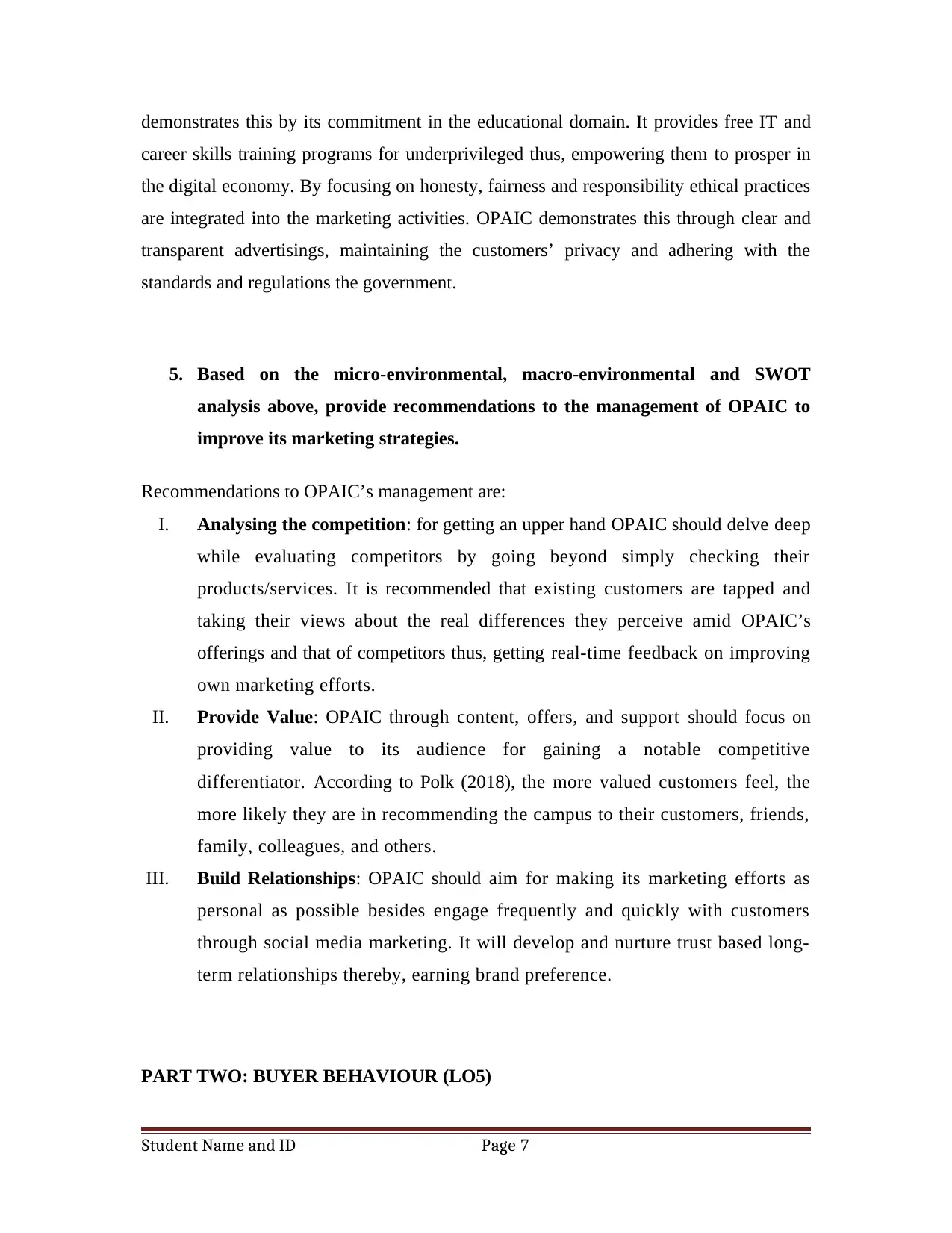
demonstrates this by its commitment in the educational domain. It provides free IT and
career skills training programs for underprivileged thus, empowering them to prosper in
the digital economy. By focusing on honesty, fairness and responsibility ethical practices
are integrated into the marketing activities. OPAIC demonstrates this through clear and
transparent advertisings, maintaining the customers’ privacy and adhering with the
standards and regulations the government.
5. Based on the micro-environmental, macro-environmental and SWOT
analysis above, provide recommendations to the management of OPAIC to
improve its marketing strategies.
Recommendations to OPAIC’s management are:
I. Analysing the competition: for getting an upper hand OPAIC should delve deep
while evaluating competitors by going beyond simply checking their
products/services. It is recommended that existing customers are tapped and
taking their views about the real differences they perceive amid OPAIC’s
offerings and that of competitors thus, getting real-time feedback on improving
own marketing efforts.
II. Provide Value: OPAIC through content, offers, and support should focus on
providing value to its audience for gaining a notable competitive
differentiator. According to Polk (2018), the more valued customers feel, the
more likely they are in recommending the campus to their customers, friends,
family, colleagues, and others.
III. Build Relationships: OPAIC should aim for making its marketing efforts as
personal as possible besides engage frequently and quickly with customers
through social media marketing. It will develop and nurture trust based long-
term relationships thereby, earning brand preference.
PART TWO: BUYER BEHAVIOUR (LO5)
Student Name and ID Page 7
career skills training programs for underprivileged thus, empowering them to prosper in
the digital economy. By focusing on honesty, fairness and responsibility ethical practices
are integrated into the marketing activities. OPAIC demonstrates this through clear and
transparent advertisings, maintaining the customers’ privacy and adhering with the
standards and regulations the government.
5. Based on the micro-environmental, macro-environmental and SWOT
analysis above, provide recommendations to the management of OPAIC to
improve its marketing strategies.
Recommendations to OPAIC’s management are:
I. Analysing the competition: for getting an upper hand OPAIC should delve deep
while evaluating competitors by going beyond simply checking their
products/services. It is recommended that existing customers are tapped and
taking their views about the real differences they perceive amid OPAIC’s
offerings and that of competitors thus, getting real-time feedback on improving
own marketing efforts.
II. Provide Value: OPAIC through content, offers, and support should focus on
providing value to its audience for gaining a notable competitive
differentiator. According to Polk (2018), the more valued customers feel, the
more likely they are in recommending the campus to their customers, friends,
family, colleagues, and others.
III. Build Relationships: OPAIC should aim for making its marketing efforts as
personal as possible besides engage frequently and quickly with customers
through social media marketing. It will develop and nurture trust based long-
term relationships thereby, earning brand preference.
PART TWO: BUYER BEHAVIOUR (LO5)
Student Name and ID Page 7
Paraphrase This Document
Need a fresh take? Get an instant paraphrase of this document with our AI Paraphraser
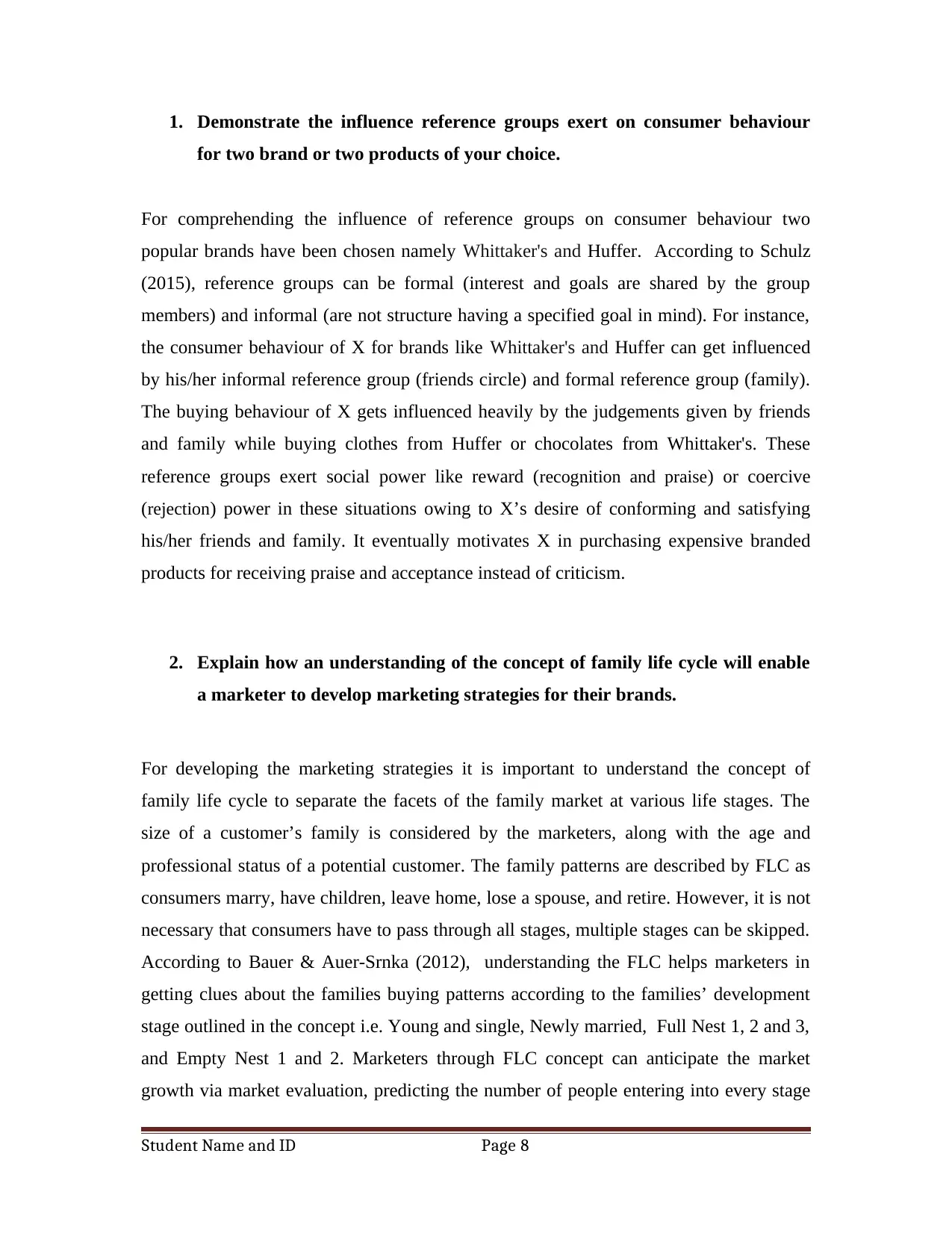
1. Demonstrate the influence reference groups exert on consumer behaviour
for two brand or two products of your choice.
For comprehending the influence of reference groups on consumer behaviour two
popular brands have been chosen namely Whittaker's and Huffer. According to Schulz
(2015), reference groups can be formal (interest and goals are shared by the group
members) and informal (are not structure having a specified goal in mind). For instance,
the consumer behaviour of X for brands like Whittaker's and Huffer can get influenced
by his/her informal reference group (friends circle) and formal reference group (family).
The buying behaviour of X gets influenced heavily by the judgements given by friends
and family while buying clothes from Huffer or chocolates from Whittaker's. These
reference groups exert social power like reward (recognition and praise) or coercive
(rejection) power in these situations owing to X’s desire of conforming and satisfying
his/her friends and family. It eventually motivates X in purchasing expensive branded
products for receiving praise and acceptance instead of criticism.
2. Explain how an understanding of the concept of family life cycle will enable
a marketer to develop marketing strategies for their brands.
For developing the marketing strategies it is important to understand the concept of
family life cycle to separate the facets of the family market at various life stages. The
size of a customer’s family is considered by the marketers, along with the age and
professional status of a potential customer. The family patterns are described by FLC as
consumers marry, have children, leave home, lose a spouse, and retire. However, it is not
necessary that consumers have to pass through all stages, multiple stages can be skipped.
According to Bauer & Auer-Srnka (2012), understanding the FLC helps marketers in
getting clues about the families buying patterns according to the families’ development
stage outlined in the concept i.e. Young and single, Newly married, Full Nest 1, 2 and 3,
and Empty Nest 1 and 2. Marketers through FLC concept can anticipate the market
growth via market evaluation, predicting the number of people entering into every stage
Student Name and ID Page 8
for two brand or two products of your choice.
For comprehending the influence of reference groups on consumer behaviour two
popular brands have been chosen namely Whittaker's and Huffer. According to Schulz
(2015), reference groups can be formal (interest and goals are shared by the group
members) and informal (are not structure having a specified goal in mind). For instance,
the consumer behaviour of X for brands like Whittaker's and Huffer can get influenced
by his/her informal reference group (friends circle) and formal reference group (family).
The buying behaviour of X gets influenced heavily by the judgements given by friends
and family while buying clothes from Huffer or chocolates from Whittaker's. These
reference groups exert social power like reward (recognition and praise) or coercive
(rejection) power in these situations owing to X’s desire of conforming and satisfying
his/her friends and family. It eventually motivates X in purchasing expensive branded
products for receiving praise and acceptance instead of criticism.
2. Explain how an understanding of the concept of family life cycle will enable
a marketer to develop marketing strategies for their brands.
For developing the marketing strategies it is important to understand the concept of
family life cycle to separate the facets of the family market at various life stages. The
size of a customer’s family is considered by the marketers, along with the age and
professional status of a potential customer. The family patterns are described by FLC as
consumers marry, have children, leave home, lose a spouse, and retire. However, it is not
necessary that consumers have to pass through all stages, multiple stages can be skipped.
According to Bauer & Auer-Srnka (2012), understanding the FLC helps marketers in
getting clues about the families buying patterns according to the families’ development
stage outlined in the concept i.e. Young and single, Newly married, Full Nest 1, 2 and 3,
and Empty Nest 1 and 2. Marketers through FLC concept can anticipate the market
growth via market evaluation, predicting the number of people entering into every stage
Student Name and ID Page 8
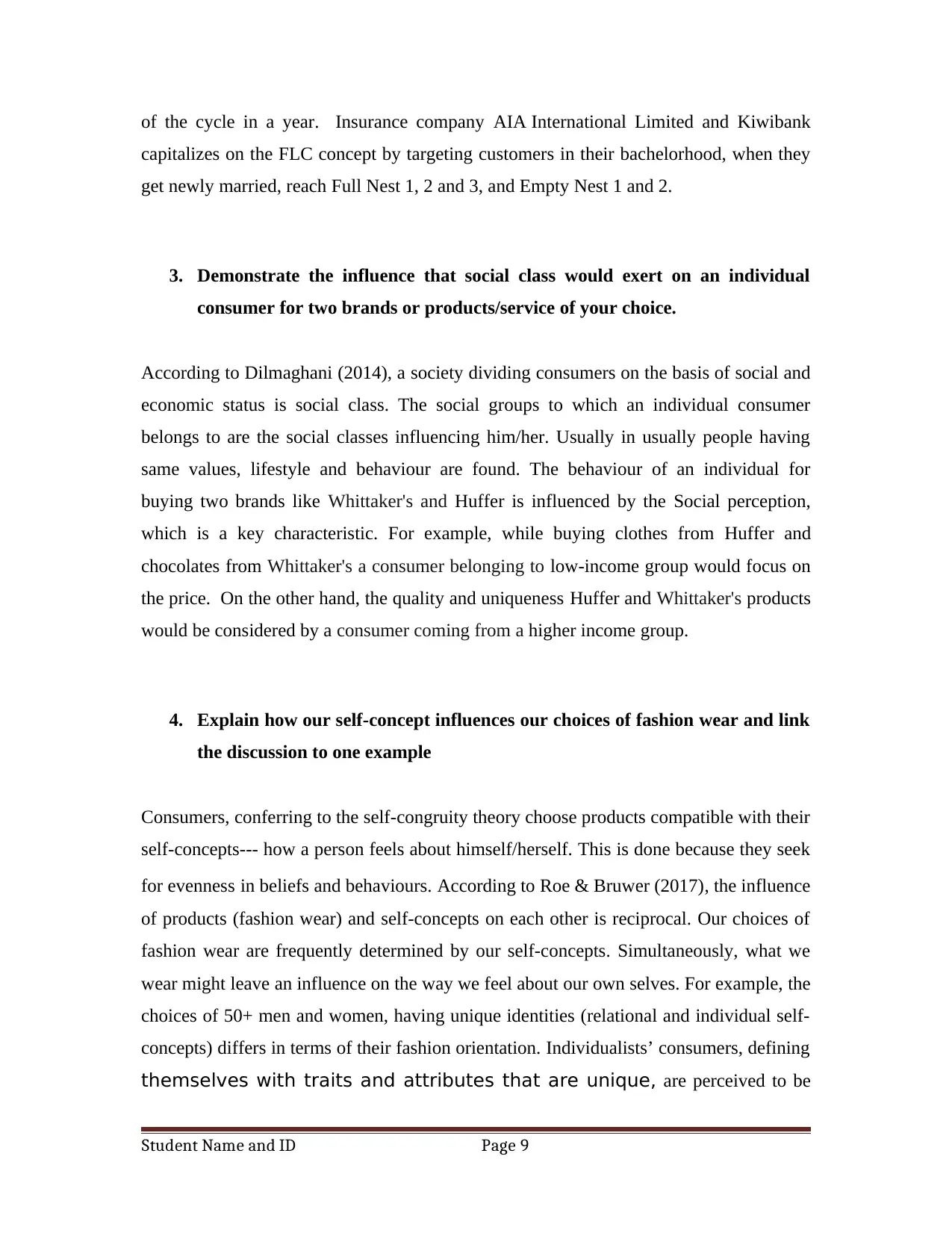
of the cycle in a year. Insurance company AIA International Limited and Kiwibank
capitalizes on the FLC concept by targeting customers in their bachelorhood, when they
get newly married, reach Full Nest 1, 2 and 3, and Empty Nest 1 and 2.
3. Demonstrate the influence that social class would exert on an individual
consumer for two brands or products/service of your choice.
According to Dilmaghani (2014), a society dividing consumers on the basis of social and
economic status is social class. The social groups to which an individual consumer
belongs to are the social classes influencing him/her. Usually in usually people having
same values, lifestyle and behaviour are found. The behaviour of an individual for
buying two brands like Whittaker's and Huffer is influenced by the Social perception,
which is a key characteristic. For example, while buying clothes from Huffer and
chocolates from Whittaker's a consumer belonging to low-income group would focus on
the price. On the other hand, the quality and uniqueness Huffer and Whittaker's products
would be considered by a consumer coming from a higher income group.
4. Explain how our self-concept influences our choices of fashion wear and link
the discussion to one example
Consumers, conferring to the self-congruity theory choose products compatible with their
self-concepts--- how a person feels about himself/herself. This is done because they seek
for evenness in beliefs and behaviours. According to Roe & Bruwer (2017), the influence
of products (fashion wear) and self-concepts on each other is reciprocal. Our choices of
fashion wear are frequently determined by our self-concepts. Simultaneously, what we
wear might leave an influence on the way we feel about our own selves. For example, the
choices of 50+ men and women, having unique identities (relational and individual self-
concepts) differs in terms of their fashion orientation. Individualists’ consumers, defining
themselves with traits and attributes that are unique, are perceived to be
Student Name and ID Page 9
capitalizes on the FLC concept by targeting customers in their bachelorhood, when they
get newly married, reach Full Nest 1, 2 and 3, and Empty Nest 1 and 2.
3. Demonstrate the influence that social class would exert on an individual
consumer for two brands or products/service of your choice.
According to Dilmaghani (2014), a society dividing consumers on the basis of social and
economic status is social class. The social groups to which an individual consumer
belongs to are the social classes influencing him/her. Usually in usually people having
same values, lifestyle and behaviour are found. The behaviour of an individual for
buying two brands like Whittaker's and Huffer is influenced by the Social perception,
which is a key characteristic. For example, while buying clothes from Huffer and
chocolates from Whittaker's a consumer belonging to low-income group would focus on
the price. On the other hand, the quality and uniqueness Huffer and Whittaker's products
would be considered by a consumer coming from a higher income group.
4. Explain how our self-concept influences our choices of fashion wear and link
the discussion to one example
Consumers, conferring to the self-congruity theory choose products compatible with their
self-concepts--- how a person feels about himself/herself. This is done because they seek
for evenness in beliefs and behaviours. According to Roe & Bruwer (2017), the influence
of products (fashion wear) and self-concepts on each other is reciprocal. Our choices of
fashion wear are frequently determined by our self-concepts. Simultaneously, what we
wear might leave an influence on the way we feel about our own selves. For example, the
choices of 50+ men and women, having unique identities (relational and individual self-
concepts) differs in terms of their fashion orientation. Individualists’ consumers, defining
themselves with traits and attributes that are unique, are perceived to be
Student Name and ID Page 9
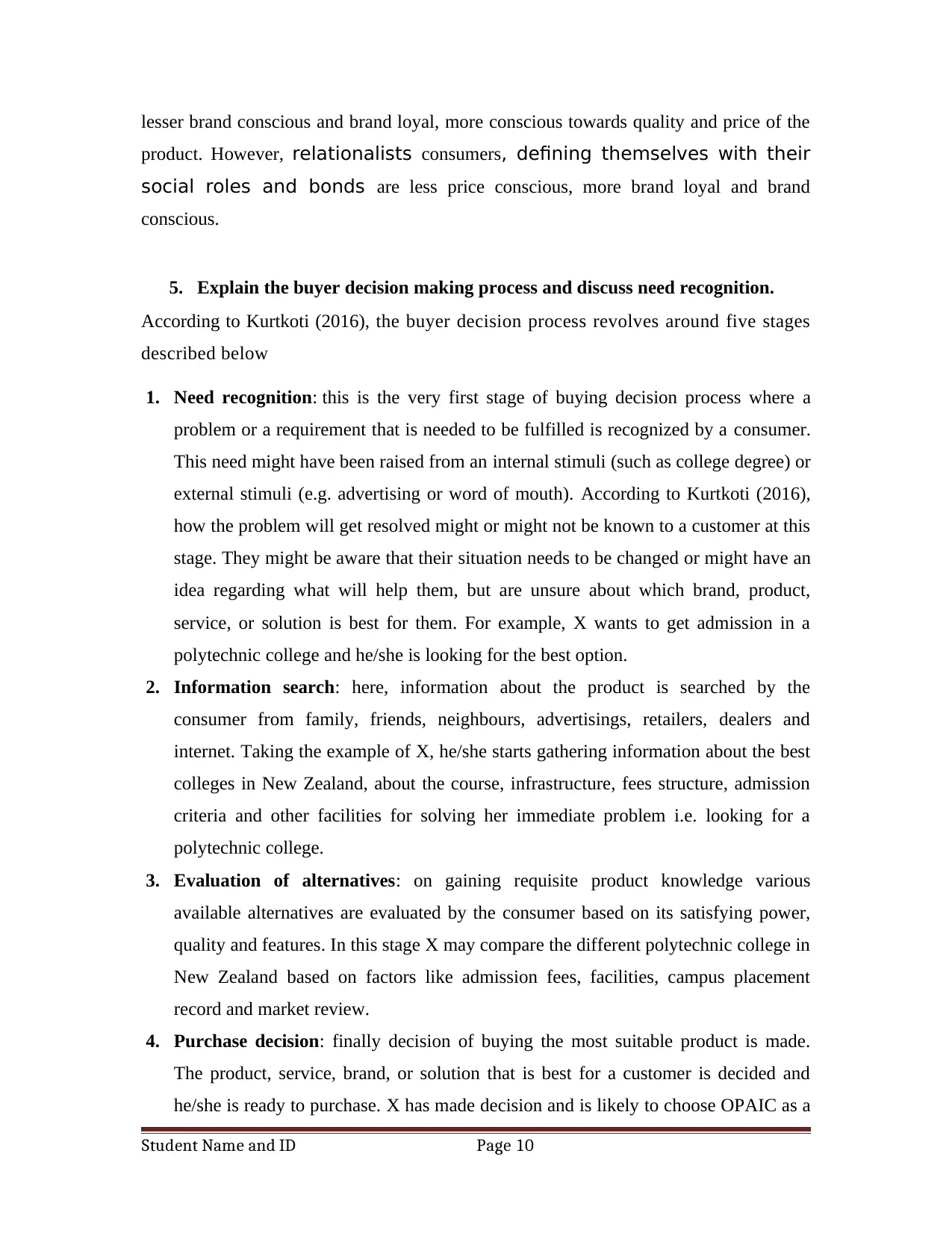
lesser brand conscious and brand loyal, more conscious towards quality and price of the
product. However, relationalists consumers, defining themselves with their
social roles and bonds are less price conscious, more brand loyal and brand
conscious.
5. Explain the buyer decision making process and discuss need recognition.
According to Kurtkoti (2016), the buyer decision process revolves around five stages
described below
1. Need recognition: this is the very first stage of buying decision process where a
problem or a requirement that is needed to be fulfilled is recognized by a consumer.
This need might have been raised from an internal stimuli (such as college degree) or
external stimuli (e.g. advertising or word of mouth). According to Kurtkoti (2016),
how the problem will get resolved might or might not be known to a customer at this
stage. They might be aware that their situation needs to be changed or might have an
idea regarding what will help them, but are unsure about which brand, product,
service, or solution is best for them. For example, X wants to get admission in a
polytechnic college and he/she is looking for the best option.
2. Information search: here, information about the product is searched by the
consumer from family, friends, neighbours, advertisings, retailers, dealers and
internet. Taking the example of X, he/she starts gathering information about the best
colleges in New Zealand, about the course, infrastructure, fees structure, admission
criteria and other facilities for solving her immediate problem i.e. looking for a
polytechnic college.
3. Evaluation of alternatives: on gaining requisite product knowledge various
available alternatives are evaluated by the consumer based on its satisfying power,
quality and features. In this stage X may compare the different polytechnic college in
New Zealand based on factors like admission fees, facilities, campus placement
record and market review.
4. Purchase decision: finally decision of buying the most suitable product is made.
The product, service, brand, or solution that is best for a customer is decided and
he/she is ready to purchase. X has made decision and is likely to choose OPAIC as a
Student Name and ID Page 10
product. However, relationalists consumers, defining themselves with their
social roles and bonds are less price conscious, more brand loyal and brand
conscious.
5. Explain the buyer decision making process and discuss need recognition.
According to Kurtkoti (2016), the buyer decision process revolves around five stages
described below
1. Need recognition: this is the very first stage of buying decision process where a
problem or a requirement that is needed to be fulfilled is recognized by a consumer.
This need might have been raised from an internal stimuli (such as college degree) or
external stimuli (e.g. advertising or word of mouth). According to Kurtkoti (2016),
how the problem will get resolved might or might not be known to a customer at this
stage. They might be aware that their situation needs to be changed or might have an
idea regarding what will help them, but are unsure about which brand, product,
service, or solution is best for them. For example, X wants to get admission in a
polytechnic college and he/she is looking for the best option.
2. Information search: here, information about the product is searched by the
consumer from family, friends, neighbours, advertisings, retailers, dealers and
internet. Taking the example of X, he/she starts gathering information about the best
colleges in New Zealand, about the course, infrastructure, fees structure, admission
criteria and other facilities for solving her immediate problem i.e. looking for a
polytechnic college.
3. Evaluation of alternatives: on gaining requisite product knowledge various
available alternatives are evaluated by the consumer based on its satisfying power,
quality and features. In this stage X may compare the different polytechnic college in
New Zealand based on factors like admission fees, facilities, campus placement
record and market review.
4. Purchase decision: finally decision of buying the most suitable product is made.
The product, service, brand, or solution that is best for a customer is decided and
he/she is ready to purchase. X has made decision and is likely to choose OPAIC as a
Student Name and ID Page 10
Secure Best Marks with AI Grader
Need help grading? Try our AI Grader for instant feedback on your assignments.
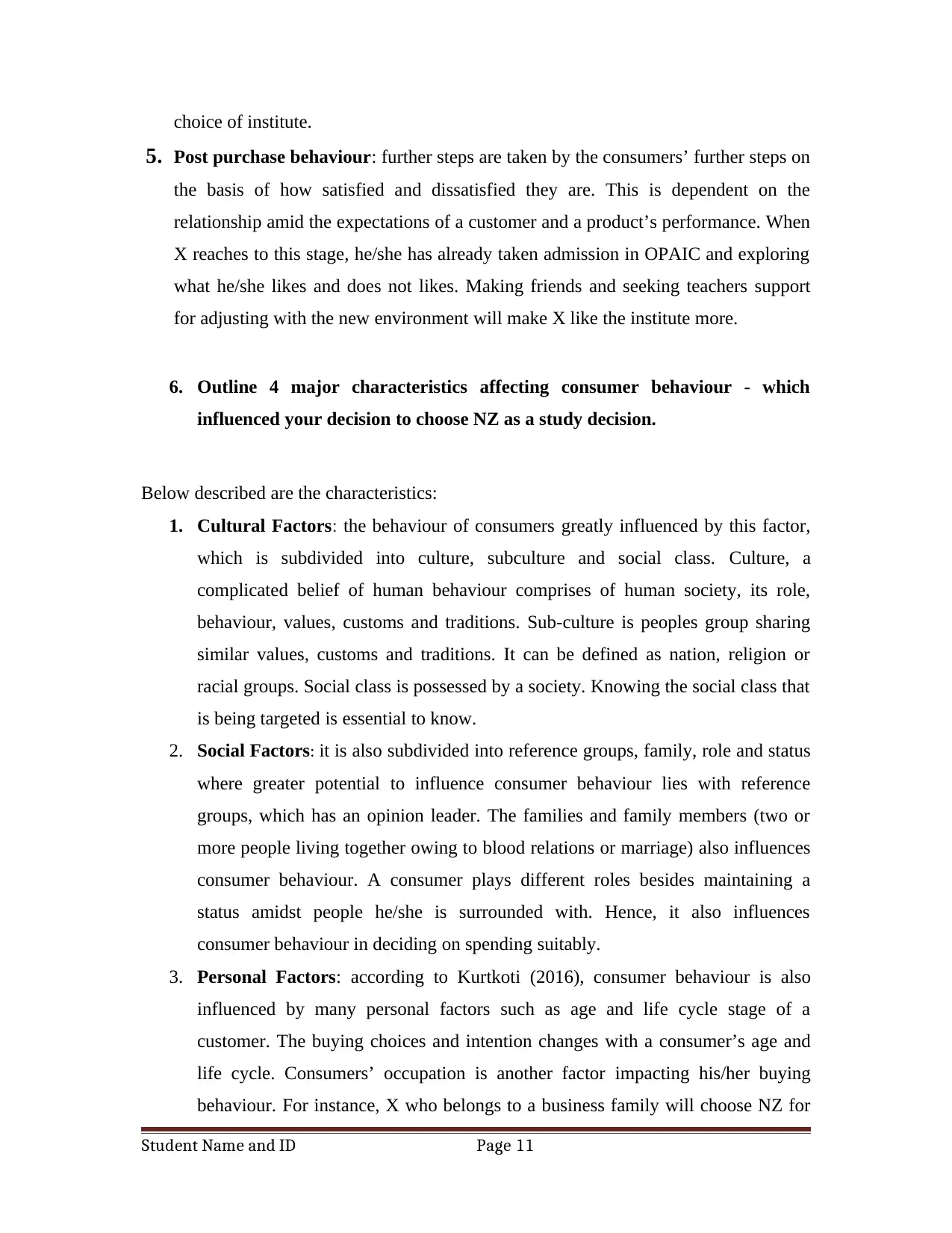
choice of institute.
5. Post purchase behaviour: further steps are taken by the consumers’ further steps on
the basis of how satisfied and dissatisfied they are. This is dependent on the
relationship amid the expectations of a customer and a product’s performance. When
X reaches to this stage, he/she has already taken admission in OPAIC and exploring
what he/she likes and does not likes. Making friends and seeking teachers support
for adjusting with the new environment will make X like the institute more.
6. Outline 4 major characteristics affecting consumer behaviour - which
influenced your decision to choose NZ as a study decision.
Below described are the characteristics:
1. Cultural Factors: the behaviour of consumers greatly influenced by this factor,
which is subdivided into culture, subculture and social class. Culture, a
complicated belief of human behaviour comprises of human society, its role,
behaviour, values, customs and traditions. Sub-culture is peoples group sharing
similar values, customs and traditions. It can be defined as nation, religion or
racial groups. Social class is possessed by a society. Knowing the social class that
is being targeted is essential to know.
2. Social Factors: it is also subdivided into reference groups, family, role and status
where greater potential to influence consumer behaviour lies with reference
groups, which has an opinion leader. The families and family members (two or
more people living together owing to blood relations or marriage) also influences
consumer behaviour. A consumer plays different roles besides maintaining a
status amidst people he/she is surrounded with. Hence, it also influences
consumer behaviour in deciding on spending suitably.
3. Personal Factors: according to Kurtkoti (2016), consumer behaviour is also
influenced by many personal factors such as age and life cycle stage of a
customer. The buying choices and intention changes with a consumer’s age and
life cycle. Consumers’ occupation is another factor impacting his/her buying
behaviour. For instance, X who belongs to a business family will choose NZ for
Student Name and ID Page 11
5. Post purchase behaviour: further steps are taken by the consumers’ further steps on
the basis of how satisfied and dissatisfied they are. This is dependent on the
relationship amid the expectations of a customer and a product’s performance. When
X reaches to this stage, he/she has already taken admission in OPAIC and exploring
what he/she likes and does not likes. Making friends and seeking teachers support
for adjusting with the new environment will make X like the institute more.
6. Outline 4 major characteristics affecting consumer behaviour - which
influenced your decision to choose NZ as a study decision.
Below described are the characteristics:
1. Cultural Factors: the behaviour of consumers greatly influenced by this factor,
which is subdivided into culture, subculture and social class. Culture, a
complicated belief of human behaviour comprises of human society, its role,
behaviour, values, customs and traditions. Sub-culture is peoples group sharing
similar values, customs and traditions. It can be defined as nation, religion or
racial groups. Social class is possessed by a society. Knowing the social class that
is being targeted is essential to know.
2. Social Factors: it is also subdivided into reference groups, family, role and status
where greater potential to influence consumer behaviour lies with reference
groups, which has an opinion leader. The families and family members (two or
more people living together owing to blood relations or marriage) also influences
consumer behaviour. A consumer plays different roles besides maintaining a
status amidst people he/she is surrounded with. Hence, it also influences
consumer behaviour in deciding on spending suitably.
3. Personal Factors: according to Kurtkoti (2016), consumer behaviour is also
influenced by many personal factors such as age and life cycle stage of a
customer. The buying choices and intention changes with a consumer’s age and
life cycle. Consumers’ occupation is another factor impacting his/her buying
behaviour. For instance, X who belongs to a business family will choose NZ for
Student Name and ID Page 11
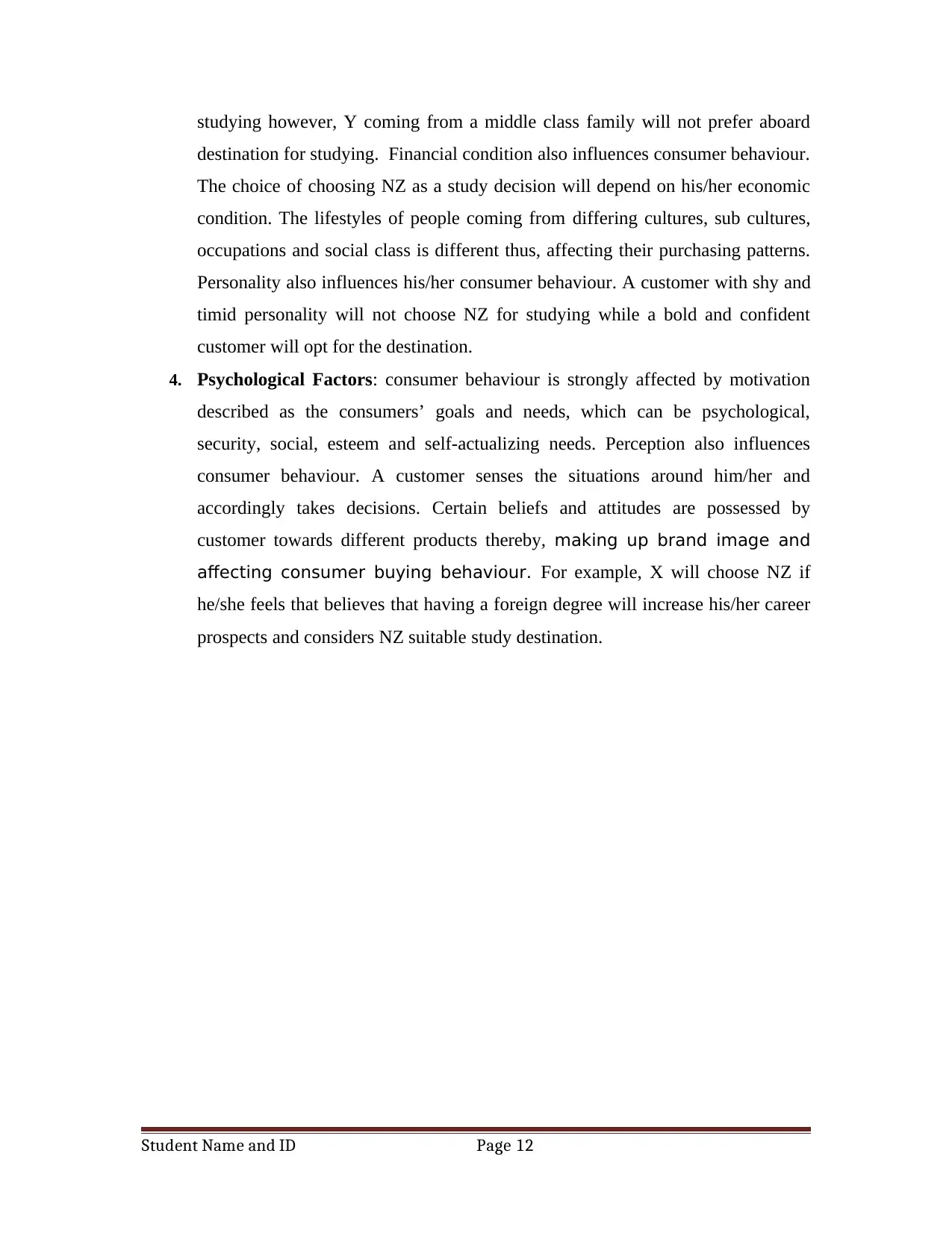
studying however, Y coming from a middle class family will not prefer aboard
destination for studying. Financial condition also influences consumer behaviour.
The choice of choosing NZ as a study decision will depend on his/her economic
condition. The lifestyles of people coming from differing cultures, sub cultures,
occupations and social class is different thus, affecting their purchasing patterns.
Personality also influences his/her consumer behaviour. A customer with shy and
timid personality will not choose NZ for studying while a bold and confident
customer will opt for the destination.
4. Psychological Factors: consumer behaviour is strongly affected by motivation
described as the consumers’ goals and needs, which can be psychological,
security, social, esteem and self-actualizing needs. Perception also influences
consumer behaviour. A customer senses the situations around him/her and
accordingly takes decisions. Certain beliefs and attitudes are possessed by
customer towards different products thereby, making up brand image and
affecting consumer buying behaviour. For example, X will choose NZ if
he/she feels that believes that having a foreign degree will increase his/her career
prospects and considers NZ suitable study destination.
Student Name and ID Page 12
destination for studying. Financial condition also influences consumer behaviour.
The choice of choosing NZ as a study decision will depend on his/her economic
condition. The lifestyles of people coming from differing cultures, sub cultures,
occupations and social class is different thus, affecting their purchasing patterns.
Personality also influences his/her consumer behaviour. A customer with shy and
timid personality will not choose NZ for studying while a bold and confident
customer will opt for the destination.
4. Psychological Factors: consumer behaviour is strongly affected by motivation
described as the consumers’ goals and needs, which can be psychological,
security, social, esteem and self-actualizing needs. Perception also influences
consumer behaviour. A customer senses the situations around him/her and
accordingly takes decisions. Certain beliefs and attitudes are possessed by
customer towards different products thereby, making up brand image and
affecting consumer buying behaviour. For example, X will choose NZ if
he/she feels that believes that having a foreign degree will increase his/her career
prospects and considers NZ suitable study destination.
Student Name and ID Page 12
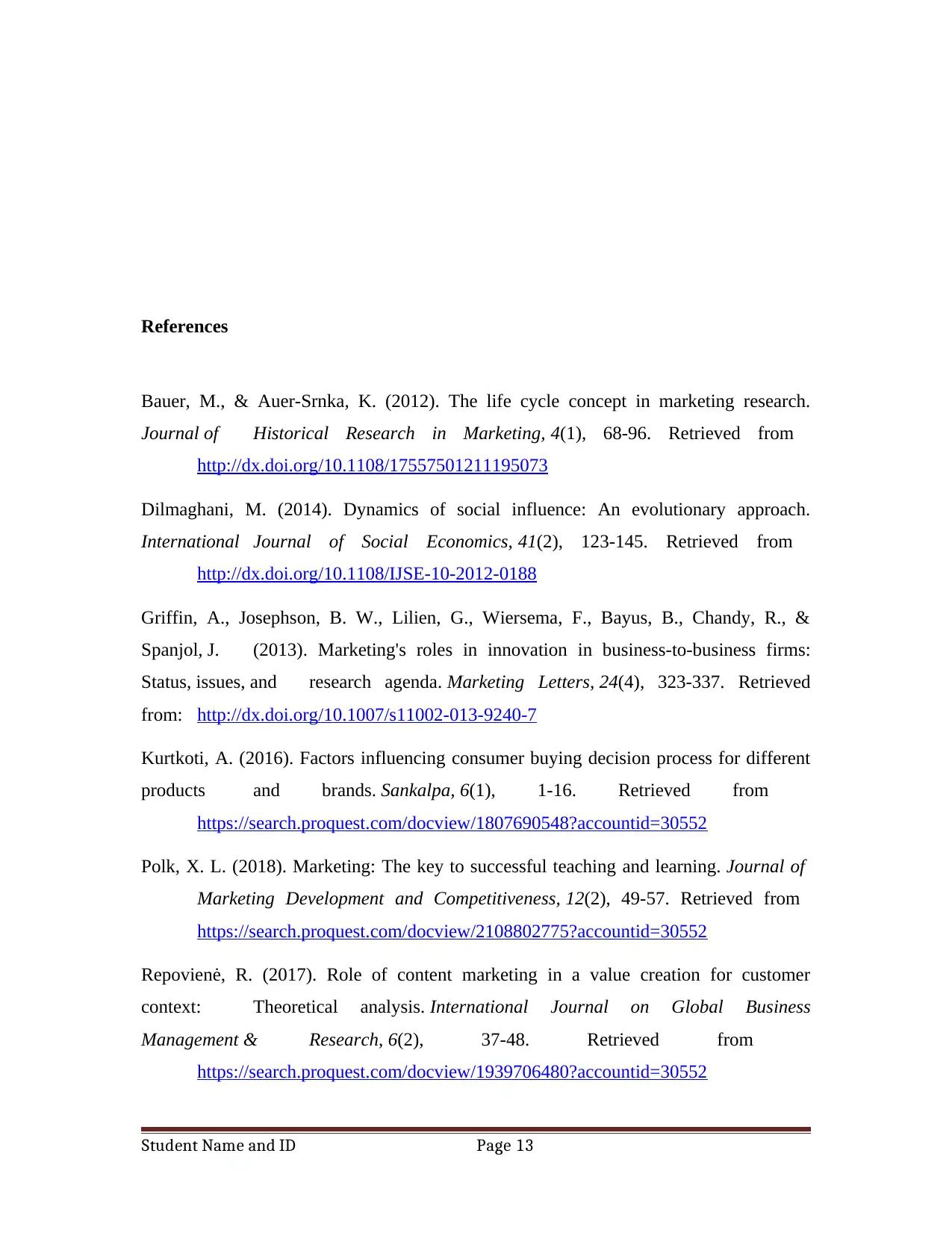
References
Bauer, M., & Auer-Srnka, K. (2012). The life cycle concept in marketing research.
Journal of Historical Research in Marketing, 4(1), 68-96. Retrieved from
http://dx.doi.org/10.1108/17557501211195073
Dilmaghani, M. (2014). Dynamics of social influence: An evolutionary approach.
International Journal of Social Economics, 41(2), 123-145. Retrieved from
http://dx.doi.org/10.1108/IJSE-10-2012-0188
Griffin, A., Josephson, B. W., Lilien, G., Wiersema, F., Bayus, B., Chandy, R., &
Spanjol, J. (2013). Marketing's roles in innovation in business-to-business firms:
Status, issues, and research agenda. Marketing Letters, 24(4), 323-337. Retrieved
from: http://dx.doi.org/10.1007/s11002-013-9240-7
Kurtkoti, A. (2016). Factors influencing consumer buying decision process for different
products and brands. Sankalpa, 6(1), 1-16. Retrieved from
https://search.proquest.com/docview/1807690548?accountid=30552
Polk, X. L. (2018). Marketing: The key to successful teaching and learning. Journal of
Marketing Development and Competitiveness, 12(2), 49-57. Retrieved from
https://search.proquest.com/docview/2108802775?accountid=30552
Repovienė, R. (2017). Role of content marketing in a value creation for customer
context: Theoretical analysis. International Journal on Global Business
Management & Research, 6(2), 37-48. Retrieved from
https://search.proquest.com/docview/1939706480?accountid=30552
Student Name and ID Page 13
Bauer, M., & Auer-Srnka, K. (2012). The life cycle concept in marketing research.
Journal of Historical Research in Marketing, 4(1), 68-96. Retrieved from
http://dx.doi.org/10.1108/17557501211195073
Dilmaghani, M. (2014). Dynamics of social influence: An evolutionary approach.
International Journal of Social Economics, 41(2), 123-145. Retrieved from
http://dx.doi.org/10.1108/IJSE-10-2012-0188
Griffin, A., Josephson, B. W., Lilien, G., Wiersema, F., Bayus, B., Chandy, R., &
Spanjol, J. (2013). Marketing's roles in innovation in business-to-business firms:
Status, issues, and research agenda. Marketing Letters, 24(4), 323-337. Retrieved
from: http://dx.doi.org/10.1007/s11002-013-9240-7
Kurtkoti, A. (2016). Factors influencing consumer buying decision process for different
products and brands. Sankalpa, 6(1), 1-16. Retrieved from
https://search.proquest.com/docview/1807690548?accountid=30552
Polk, X. L. (2018). Marketing: The key to successful teaching and learning. Journal of
Marketing Development and Competitiveness, 12(2), 49-57. Retrieved from
https://search.proquest.com/docview/2108802775?accountid=30552
Repovienė, R. (2017). Role of content marketing in a value creation for customer
context: Theoretical analysis. International Journal on Global Business
Management & Research, 6(2), 37-48. Retrieved from
https://search.proquest.com/docview/1939706480?accountid=30552
Student Name and ID Page 13
Paraphrase This Document
Need a fresh take? Get an instant paraphrase of this document with our AI Paraphraser

Roe, D., & Bruwer, J. (2017). Self-concept, product involvement and consumption
occasions. British Food Journal, 119(6), 1362-1377. Retrieved from
http://dx.doi.org/10.1108/BFJ-10-2016-0476
Schulz, H. M. (2015). Reference group influence in consumer role rehearsal
narratives. Qualitative Market Research, 18(2), 210-229. Retrieved from
https://search.proquest.com/docview/1675122807?accountid=30552
Soni, S., & Soni, A. (2014). Cause related marketing: An ethical quandary or an altruistic
charity. International Journal of Business Ethics in Developing Economies, 3(2)
Retrieved from https://search.proquest.com/docview/1733201750?
accountid=30552
Struwig, F. W., Krüger, J., & Nuwagaba, G. (2019). The influence of the business
environment on the growth of informal businesses in uganda. The Southern African
Journal of Entrepreneurship and Small Business Management, 11(1) Retrieved from
http://dx.doi.org/10.4102/sajesbm.v11i1.200
Trifu, A. E., Girneata, A., & Potcovaru, M. (2014). Influence of natural factors upon the
organization activities. Revista De Management Comparat International, 15(4),
487-496. Retrieved from https://search.proquest.com/docview/1667653325?
accountid=30552
Tsygankova, T., & Ponomarenko, R. (2016). Key determinants of managing the
marketing asset of global companies. International Economic Policy, (25), 75-97.
Retrieved from https://search.proquest.com/docview/1894933069?
accountid=30552
Student Name and ID Page 14
occasions. British Food Journal, 119(6), 1362-1377. Retrieved from
http://dx.doi.org/10.1108/BFJ-10-2016-0476
Schulz, H. M. (2015). Reference group influence in consumer role rehearsal
narratives. Qualitative Market Research, 18(2), 210-229. Retrieved from
https://search.proquest.com/docview/1675122807?accountid=30552
Soni, S., & Soni, A. (2014). Cause related marketing: An ethical quandary or an altruistic
charity. International Journal of Business Ethics in Developing Economies, 3(2)
Retrieved from https://search.proquest.com/docview/1733201750?
accountid=30552
Struwig, F. W., Krüger, J., & Nuwagaba, G. (2019). The influence of the business
environment on the growth of informal businesses in uganda. The Southern African
Journal of Entrepreneurship and Small Business Management, 11(1) Retrieved from
http://dx.doi.org/10.4102/sajesbm.v11i1.200
Trifu, A. E., Girneata, A., & Potcovaru, M. (2014). Influence of natural factors upon the
organization activities. Revista De Management Comparat International, 15(4),
487-496. Retrieved from https://search.proquest.com/docview/1667653325?
accountid=30552
Tsygankova, T., & Ponomarenko, R. (2016). Key determinants of managing the
marketing asset of global companies. International Economic Policy, (25), 75-97.
Retrieved from https://search.proquest.com/docview/1894933069?
accountid=30552
Student Name and ID Page 14
1 out of 14
Related Documents
Your All-in-One AI-Powered Toolkit for Academic Success.
+13062052269
info@desklib.com
Available 24*7 on WhatsApp / Email
![[object Object]](/_next/static/media/star-bottom.7253800d.svg)
Unlock your academic potential
© 2024 | Zucol Services PVT LTD | All rights reserved.





